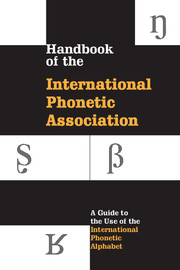 Handbook of the International Phonetic Association
Handbook of the International Phonetic Association PART I - Introduction to the IPA
Published online by Cambridge University Press: 06 November 2023
Summary
1 What is the International Phonetic Alphabet?
The aim of the International Phonetic Association is to promote the study of the science of phonetics and the various practical applications of that science. For both these it is desirable to have a consistent way of representing the sounds of language in written form. From its foundation in 1886 the Association has been concerned to develop a set of symbols which would be convenient to use, but comprehensive enough to cope with the wide variety of sounds found in the languages of the world; and to encourage the use of this notation as widely as possible among those concerned with language. The system is generally known as the International Phonetic Alphabet. Both the Association and its Alphabet are widely referred to by the abbreviation IPA, and here the Alphabet will generally be abbreviated to ‘the IPA’. The IPA is based on the Roman alphabet, which has the advantage of being widely familiar, but also includes letters and additional symbols from a variety of other sources. These additions are necessary because the variety of sounds in languages is much greater than the number of letters in the Roman alphabet. The use of sequences of phonetic symbols to represent speech is known as transcription.
The IPA can be used for many purposes. For instance, it can be used as a way to show pronunciation in a dictionary, to record a language in linguistic fieldwork, to form the basis of a writing system for a language, or to annotate acoustic and other displays in the analysis of speech. For all these tasks it is necessary to have a generally agreed set of symbols for designating sounds unambiguously, and the IPA aims to fulfil this role. The purpose of this Handbook is to provide a practical guide to the IPA and to the conventions associated with it.
Phonetics, like any science, develops over time. New facts emerge, new theories are created, and new solutions to old problems are invented. The notational system of any science reflects facts and theories, and so it is natural that from time to time the Alphabet should be modified to accommodate innovations.
- Type
- Chapter
- Information
- Handbook of the International Phonetic AssociationA Guide to the Use of the International Phonetic Alphabet, pp. 1 - 38Publisher: Cambridge University PressPrint publication year: 1999
